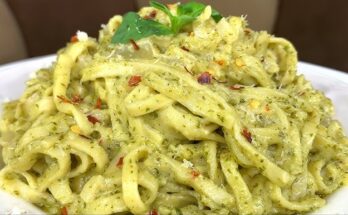Cheesy Grits Recipe: If you’re craving a warm, creamy, and comforting dish that speaks the language of the American South, then cheesy grits should be at the top of your list. This dish has been cherished for generations, loved for its versatility, and celebrated for its rich, soul-satisfying taste. Whether you serve it for breakfast alongside bacon and eggs, as a base for shrimp, or as a hearty dinner side dish, cheesy grits never disappoint.
Why Cheesy Grits Are a Southern Classic
Cheesy grits aren’t just food—they’re culture. Originating from Native American traditions, grits have been a staple in the Southern diet for centuries. Over time, the addition of cheese elevated this humble dish into something luxurious yet comforting. The creamy texture of slow-cooked grits combined with the sharpness of melted cheese creates a flavor balance that feels both indulgent and wholesome. They’re the kind of meal that reminds you of family gatherings, lazy Sunday mornings, and comfort food at its finest.
The Comfort Food Appeal of Grits
Think of cheesy grits as a culinary hug in a bowl. They’re warm, rich, and customizable. Just like mashed potatoes or mac and cheese, grits provide that same level of satisfaction when you take a spoonful. The addition of cheese gives them a creamy, gooey consistency that feels like pure comfort. Whether you’re enjoying them as a simple breakfast or dressing them up for dinner with shrimp or sausage, cheesy grits always bring a sense of homestyle cooking to the table.
Ingredients You’ll Need
Making cheesy grits is simple, but the key lies in choosing the right ingredients. Fresh, high-quality components make all the difference between bland grits and a dish that bursts with flavor.
Essential Ingredients for Cheesy Grits
Here’s a list of the basic ingredients you’ll need to make the perfect pot of cheesy grits:
- Grits (stone-ground or quick-cooking)
- Water or chicken broth (for cooking liquid)
- Milk or heavy cream (adds creaminess)
- Cheese (cheddar is most popular, but other types work well)
- Butter (for richness)
- Salt and black pepper (for seasoning)
Each ingredient has its purpose. The grits are, of course, the star of the dish, while the broth and milk infuse flavor and creaminess. Butter and cheese create that velvety richness, and simple seasonings like salt and pepper tie it all together.
Choosing the Best Cheese for Flavor
Cheddar is the go-to cheese for most cheesy grits recipes because it provides a sharp flavor that balances the creamy grits. However, you can get creative:
- Sharp cheddar – bold and tangy
- Parmesan – nutty and slightly salty
- Gruyère – smooth and melts beautifully
- Pepper Jack – adds a spicy kick
- Cream cheese – enhances creaminess without overpowering
The type of cheese you choose can completely transform the flavor profile, so feel free to experiment depending on your taste preferences.
Optional Add-Ons for Extra Taste
Want to elevate your cheesy grits? Try adding:
- Garlic or onion powder for savory depth
- Fresh herbs like parsley, chives, or thyme
- Hot sauce or chili flakes for spice lovers
- Crumbled bacon or sausage for smoky richness
These add-ons take basic cheesy grits from good to unforgettable.
Kitchen Tools and Equipment
Just like with any recipe, having the right tools makes the process easier and the results more consistent.
Must-Have Tools for Perfect Grits
- Medium or large saucepan – for cooking the grits evenly
- Whisk – essential for stirring to prevent lumps
- Measuring cups and spoons – for accuracy
- Wooden spoon or spatula – for mixing cheese and butter into the grits
- Serving bowls – preferably warmed to keep grits hot
A whisk is the secret weapon when making grits. Since grits can clump easily, constant whisking ensures a smooth, lump-free texture.
Tips for Using Cast Iron or Nonstick Pots
Some people prefer cooking grits in cast iron for even heating and traditional flavor, while others go for nonstick pots to prevent sticking. Either works fine, but keep these tips in mind:
- Cast iron: Great heat retention, but requires more stirring to prevent sticking.
- Nonstick: Easier cleanup, but avoid using metal utensils.
- Stainless steel: A good balance but can scorch grits if not stirred frequently.
Choose the pot that works best for your cooking style and kitchen setup.
Step-by-Step Guide to Making Cheesy Grits
This is where the magic happens. Making cheesy grits is a straightforward process, but it’s important to follow the steps carefully to get that creamy, dreamy consistency.
Step 1 – Preparing the Grits Base
Start by boiling your cooking liquid—this could be water, broth, or a combination of broth and milk. Using broth gives the grits more flavor right from the start. Once the liquid is boiling, slowly whisk in the grits. Don’t dump them all in at once; instead, sprinkle them in gradually while whisking constantly to avoid lumps.
At this stage, patience is key. Allow the grits to absorb the liquid and expand. This creates the foundation for the creamy texture you’re aiming for. Reduce the heat to low and keep whisking occasionally to ensure nothing sticks to the bottom of the pot.
Step 2 – Cooking the Grits to Creamy Perfection
Once the grits are simmering, the real transformation begins. Cooking grits properly requires low and slow heat. If you rush this process, you’ll end up with gritty, undercooked grains instead of smooth, velvety goodness. Keep the pot on low heat and stir frequently. Stirring helps release the starch from the grits, which is what gives them that naturally creamy texture.
Depending on the type of grits you’re using, cooking times can vary:
- Instant grits: 5–7 minutes
- Quick-cooking grits: 10–15 minutes
- Stone-ground grits: 30–45 minutes
Stone-ground grits take longer, but they deliver the best flavor and texture. As the grits cook, you may need to add more liquid if they get too thick. A splash of milk, cream, or broth will keep them from drying out. By the end of this step, the grits should be thick yet spoonable—soft enough to spread slightly but firm enough to hold their shape in a bowl.
Step 3 – Adding Cheese for Rich Flavor
Once your grits have reached the perfect creamy consistency, it’s time to add the star ingredient—cheese. Remove the pot from direct heat before stirring in the cheese. This prevents the cheese from breaking or becoming grainy. Start with shredded cheese and add it gradually while stirring continuously. The heat of the grits will melt the cheese into a luscious, gooey mixture.
This is also when you add butter for extra richness. If you want a silky smooth finish, toss in a splash of heavy cream as well. Taste and adjust seasonings with salt and pepper. Remember, some cheeses are naturally salty, so season carefully to avoid overdoing it.
Step 4 – Seasoning and Final Touches
The final step is all about making your cheesy grits sing with flavor. Add in optional seasonings such as garlic powder, onion powder, or a dash of hot sauce for a little kick. Freshly ground black pepper always enhances the creamy, cheesy base.
For presentation, you can garnish with chopped herbs like parsley or chives, or sprinkle a bit of extra cheese on top. If serving with breakfast, top with a fried egg or crispy bacon. For dinner, cheesy grits pair beautifully with shrimp, grilled chicken, or roasted vegetables.
Serving Ideas for Cheesy Grits
One of the best things about cheesy grits is their versatility. You can enjoy them at any time of the day, and they pair well with a variety of dishes.
Pairing with Breakfast Favorites
Cheesy grits make an excellent companion to a hearty breakfast plate. Serve them alongside scrambled eggs, crispy bacon, or sausage links for a meal that will keep you full all morning. They also pair beautifully with buttered toast, biscuits, or cornbread.
For a fancier twist, top your cheesy grits with a perfectly poached egg. When you break into the yolk, it flows into the grits, creating a rich and indulgent bite. You can also drizzle hot sauce over the top if you like a little spice with your breakfast.
Cheesy Grits as a Dinner Side Dish
Cheesy grits aren’t just for breakfast—they shine as a savory side dish at dinner, too. They go particularly well with:
- Shrimp – the classic shrimp and grits combination
- Grilled or roasted meats – chicken, pork, or steak
- Seafood – catfish, salmon, or crab cakes
- Vegetables – roasted asparagus, sautéed greens, or mushrooms
Because cheesy grits are mild and creamy, they balance out bold, savory dishes beautifully. They soak up sauces and gravies like a sponge, making them the perfect partner for Southern-inspired meals.
Variations of Cheesy Grits Recipe
While classic cheesy grits are delicious on their own, you can take things up a notch by experimenting with different flavors and add-ins.
Shrimp and Cheesy Grits
This is perhaps the most famous variation. Juicy shrimp are sautéed with garlic, butter, and a touch of spice, then spooned over a creamy bed of cheesy grits. The richness of the grits balances the bold flavors of the shrimp, creating a dish that’s both comforting and sophisticated. It’s a restaurant-worthy meal you can easily make at home.
Spicy Jalapeño Cheesy Grits
If you like a little heat, try adding diced jalapeños or green chilies to your cheesy grits. Pepper Jack cheese works beautifully here because it melts well and adds a mild kick. Top with a sprinkle of smoked paprika for a smoky-spicy flavor combination.
Baked Cheesy Grits Casserole
Want a dish that’s perfect for potlucks or family gatherings? Try turning your cheesy grits into a baked casserole. Simply mix cooked grits with cheese, butter, and eggs, then bake until golden and bubbly. The result is a firm, sliceable dish that’s easy to serve and utterly delicious.
Storage and Reheating Tips
Cheesy grits taste best when served fresh and hot, but let’s be real—sometimes you end up with leftovers. Instead of tossing them, you can store and reheat them to enjoy later. The key is knowing how to keep their creamy texture intact.
How to Store Cheesy Grits Properly
When storing cheesy grits, let them cool to room temperature first. Placing hot grits directly into the fridge can cause condensation, which leads to watery leftovers. Once cooled, transfer them into an airtight container. Properly stored, cheesy grits can last:
- In the refrigerator: 3 to 4 days
- In the freezer: Up to 1 month
If you’re freezing grits, spread them out on a parchment-lined baking sheet first and let them freeze in a flat layer. Once solid, transfer the portions into freezer bags. This method makes reheating easier since you can thaw just what you need.
Best Ways to Reheat Without Losing Texture
The biggest challenge with reheating cheesy grits is preventing them from drying out or becoming clumpy. Here are the best methods:
- Stovetop method: Place grits in a saucepan over low heat. Add a splash of milk, cream, or broth, and stir until they return to their original creamy consistency.
- Microwave method: Transfer grits to a microwave-safe bowl. Add a little liquid, cover, and heat in short intervals, stirring in between.
- Oven method: Best for baked cheesy grits casseroles. Cover with foil and reheat at 350°F until warmed through.
Avoid reheating grits without adding extra liquid, as they tend to firm up when cold. A little patience and added moisture will bring them back to life.
Nutritional Value of Cheesy Grits
Cheesy grits are indulgent, but that doesn’t mean they can’t fit into a balanced diet. Knowing their nutritional profile helps you enjoy them without guilt.
Calories and Macros Breakdown
On average, one serving (about 1 cup) of cheesy grits contains:
- Calories: 250–350
- Carbohydrates: 30–35g
- Protein: 7–10g
- Fat: 10–15g
- Fiber: 1–2g
The exact numbers depend on the type of grits and cheese you use, as well as how much butter or cream you add. While cheesy grits are relatively high in carbs, they also provide protein and calcium from the cheese and milk.
Making Cheesy Grits Healthier
If you want to enjoy cheesy grits with fewer calories or less fat, try these simple swaps:
- Use skim milk or low-fat milk instead of cream.
- Reduce the butter and add a little olive oil instead.
- Use a smaller amount of sharp cheese, which gives you more flavor with less quantity.
- Add vegetables like spinach, mushrooms, or tomatoes for extra nutrients.
These tweaks lighten up the dish while keeping it just as satisfying.
Common Mistakes to Avoid
Even though cheesy grits are simple to make, a few missteps can ruin their texture or flavor. Here’s what to watch out for:
Overcooking or Undercooking Grits
Undercooked grits taste raw and gritty, while overcooked grits can become pasty and heavy. The secret is to follow the cooking time carefully and taste along the way. The texture should be smooth, soft, and slightly creamy—not watery, not stiff.
Another tip: don’t rush the cooking process. Grits need low, steady heat and regular stirring. If you cook them too fast, you risk lumps or burning.
Using the Wrong Type of Cheese
Not all cheeses melt well. Hard, aged cheeses like Parmesan add flavor but don’t create creaminess on their own. On the other hand, soft cheeses like cream cheese or American cheese melt smoothly but lack bold flavor.
The best cheesy grits combine a melty cheese for creaminess (like cheddar or Gruyère) with a flavorful cheese (like Parmesan or sharp cheddar) for depth. Avoid pre-shredded cheese if possible, since it contains anti-caking agents that prevent smooth melting.
FAQs about Cheesy Grits Recipe
1. Can I use instant grits for this recipe?
Yes, you can, but keep in mind that instant grits cook quickly and don’t have the same depth of flavor as stone-ground grits. They’re a good option if you’re short on time.
2. What cheese works best in cheesy grits?
Sharp cheddar is the most popular choice because it adds bold flavor, but you can mix in Parmesan, Gruyère, or Pepper Jack for variety.
3. How do I keep grits from getting lumpy?
Always whisk your grits slowly into boiling liquid, and stir frequently during cooking. This prevents clumps from forming.
4. Can I make vegan cheesy grits?
Yes! Use plant-based milk (like almond or oat), vegan butter, and dairy-free cheese. Nutritional yeast also adds a cheesy flavor without dairy.
5. How long can I store leftover cheesy grits?
In the fridge, they last up to 4 days. If frozen properly, they can last for about a month. Just remember to reheat with a splash of liquid to restore creaminess.
Conclusion
Cheesy grits are more than just a dish—they’re a Southern tradition, a comfort food, and a versatile base for endless variations. From a simple breakfast side to a gourmet dinner centerpiece, cheesy grits bring warmth and satisfaction to the table. With the right ingredients, tools, and a little patience, you can whip up a creamy, cheesy bowl of goodness that rivals any restaurant version.
Whether you’re serving them with eggs, pairing them with shrimp, or baking them into a hearty casserole, cheesy grits will always win hearts and stomachs. Once you master the basic recipe, the possibilities are endless. So grab your whisk, pick your favorite cheese, and make yourself a bowl of cheesy happiness today.



